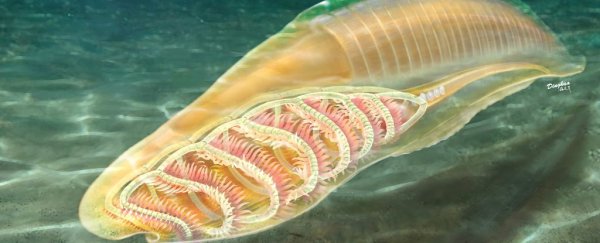A strange creature that sloshed about in Earth's oceans over half a billion years ago seems to be the earliest vertebrate relative we've found to date.
They're called yunnanozoans, dating to the Early Cambrian some 518 million years ago. Cartilaginous features found in their fossilized remains are comparable to modern vertebrates, paleontologists have discovered.
This suggests that the animals are stem vertebrates, an extinct sister-group to the group from which modern vertebrates are descended.
"Pharyngeal arches are a key innovation that likely contributed to the evolution of the jaws and braincase of vertebrates," wrote the team, led by Qingyi Tian of Nanjing University and the Chinese Academy of Sciences in China.
"The pharyngeal skeleton of controversial Cambrian animals called yunnanozoans may contain the oldest fossil evidence constraining the early evolution of the arches, yet its correlation with that of vertebrates is still disputed.
"By examining additional specimens in previously unexplored techniques .. we found evidence that yunnanozoan branchial arches consist of cellular cartilage with an extracellular matrix dominated by microfibrils, a feature hitherto considered specific to vertebrates."
Tracking the evolution of vertebrates back to their murky beginnings has been a difficult task for scientists. Over hundreds of millions of years, traces of life erode and degrade; fossils can be left behind, if conditions are right, but those are often extremely hard to interpret, especially for the very old, very strange ones.
Yunnanozoans are very old, and plenty strange. For decades, scientists have been puzzling over where this creature fits in the tree of life, based on studies and competing interpretations of ancient fossils recovered from the Maotianshan Shales in China.
It was in the hope of clarifying the issue that Tian and his colleagues embarked on a study of 127 newly collected yunnanozoan fossils.
 A fossilized yunnanozoan. (Fangchen Zhao)
A fossilized yunnanozoan. (Fangchen Zhao)
These fossils were subjected to a range of techniques that had not been applied to yunnanozoans before, including X-ray microtomography, scanning and transmission electron microscopy, Raman spectrometry, and energy dispersive spectrometry element mapping. Their results revealed previously unknown details about yunnanozoans anatomy.
The pharyngeal arch is a structure that can be found during the embryonic development of vertebrate organisms, and is the precursor to a number of different parts of the face and jaw, depending on the organism.
In fish, these arches are known as branchial arches, and they provide support for the gills. Scientists believe that, in vertebrate ancestors, the pharyngeal arch evolved from an unjointed cartilage rod; although when and how it emerged is unknown.
Seven pairs of bilaterally symmetrical branchial arches had previously been identified in yunnanozoans. Tian and colleagues took a much closer look at the microscopic structures of these bars, and the way they are arranged in the body.
They found that the seven pairs of arches in the fossils are similar to each other, and that they are connected by dorsal and ventral horizontal rods, forming a basket-like structure.
They also found that the branchial arches are composed of cartilage within a densely packed microfibril matrix. These microfibrils, they found, are similar to microfibrils found in vertebrate connective tissue. It's a combination of features broadly present in modern vertebrates: cartilage in a microfibril matrix, branchial arches, and the presence of horizontal bars at the ends of the branchial arches.
In addition, a basket-like structure of the pharyngeal skeleton can be found in some modern jawless fish, such as lampreys and hagfish.
"Two types of pharyngeal skeletons – the basket-like and isolated types – occur in the Cambrian and living vertebrates," Tian said. "This implies that the form of pharyngeal skeletons has a more complex early evolutionary history than previously thought."
The team's evidence is compelling for vertebrate-like structures in these mysterious animals. Although not directly related to modern vertebrates, yunnanozoans therefore might help shine some light on vertebrate evolution.
"Although evolutionary biologists have been busy chasing the mythical ancestor that explains everything about the vertebrate body plan, perhaps the opposite is a sensible approach," wrote paleobiologist Tetsuto Miyashita of the Canadian Museum of Nature in a related Science Perspective. Miyashita was not involved in the research.
"In other words, the meandering journey toward modern vertebrates may be best understood by populating the family tree with divergent and discontinuous anatomical forms, guided by phylogenetic inference rather than theory."
The team's paper has been published in Science.
